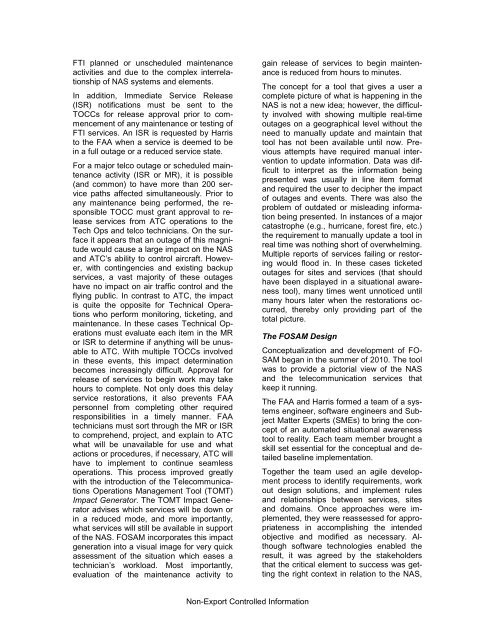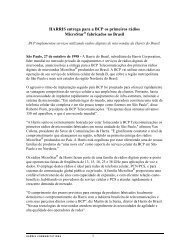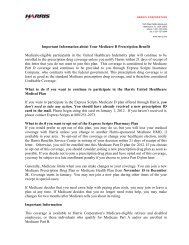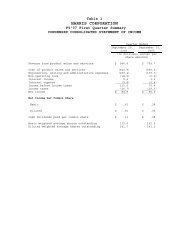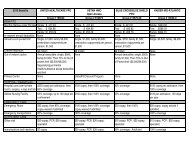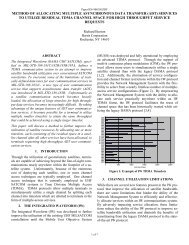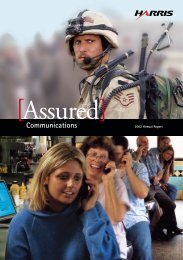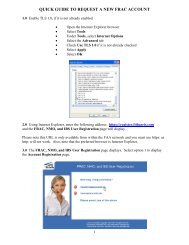Advancing Situational Awareness for Technical Operations
Advancing Situational Awareness for Technical Operations
Advancing Situational Awareness for Technical Operations
You also want an ePaper? Increase the reach of your titles
YUMPU automatically turns print PDFs into web optimized ePapers that Google loves.
FTI planned or unscheduled maintenance<br />
activities and due to the complex interrelationship<br />
of NAS systems and elements.<br />
In addition, Immediate Service Release<br />
(ISR) notifications must be sent to the<br />
TOCCs <strong>for</strong> release approval prior to commencement<br />
of any maintenance or testing of<br />
FTI services. An ISR is requested by Harris<br />
to the FAA when a service is deemed to be<br />
in a full outage or a reduced service state.<br />
For a major telco outage or scheduled maintenance<br />
activity (ISR or MR), it is possible<br />
(and common) to have more than 200 service<br />
paths affected simultaneously. Prior to<br />
any maintenance being per<strong>for</strong>med, the responsible<br />
TOCC must grant approval to release<br />
services from ATC operations to the<br />
Tech Ops and telco technicians. On the surface<br />
it appears that an outage of this magnitude<br />
would cause a large impact on the NAS<br />
and ATC’s ability to control aircraft. However,<br />
with contingencies and existing backup<br />
services, a vast majority of these outages<br />
have no impact on air traffic control and the<br />
flying public. In contrast to ATC, the impact<br />
is quite the opposite <strong>for</strong> <strong>Technical</strong> <strong>Operations</strong><br />
who per<strong>for</strong>m monitoring, ticketing, and<br />
maintenance. In these cases <strong>Technical</strong> <strong>Operations</strong><br />
must evaluate each item in the MR<br />
or ISR to determine if anything will be unusable<br />
to ATC. With multiple TOCCs involved<br />
in these events, this impact determination<br />
becomes increasingly difficult. Approval <strong>for</strong><br />
release of services to begin work may take<br />
hours to complete. Not only does this delay<br />
service restorations, it also prevents FAA<br />
personnel from completing other required<br />
responsibilities in a timely manner. FAA<br />
technicians must sort through the MR or ISR<br />
to comprehend, project, and explain to ATC<br />
what will be unavailable <strong>for</strong> use and what<br />
actions or procedures, if necessary, ATC will<br />
have to implement to continue seamless<br />
operations. This process improved greatly<br />
with the introduction of the Telecommunications<br />
<strong>Operations</strong> Management Tool (TOMT)<br />
Impact Generator. The TOMT Impact Generator<br />
advises which services will be down or<br />
in a reduced mode, and more importantly,<br />
what services will still be available in support<br />
of the NAS. FOSAM incorporates this impact<br />
generation into a visual image <strong>for</strong> very quick<br />
assessment of the situation which eases a<br />
technician’s workload. Most importantly,<br />
evaluation of the maintenance activity to<br />
Non-Export Controlled In<strong>for</strong>mation<br />
gain release of services to begin maintenance<br />
is reduced from hours to minutes.<br />
The concept <strong>for</strong> a tool that gives a user a<br />
complete picture of what is happening in the<br />
NAS is not a new idea; however, the difficulty<br />
involved with showing multiple real-time<br />
outages on a geographical level without the<br />
need to manually update and maintain that<br />
tool has not been available until now. Previous<br />
attempts have required manual intervention<br />
to update in<strong>for</strong>mation. Data was difficult<br />
to interpret as the in<strong>for</strong>mation being<br />
presented was usually in line item <strong>for</strong>mat<br />
and required the user to decipher the impact<br />
of outages and events. There was also the<br />
problem of outdated or misleading in<strong>for</strong>mation<br />
being presented. In instances of a major<br />
catastrophe (e.g., hurricane, <strong>for</strong>est fire, etc.)<br />
the requirement to manually update a tool in<br />
real time was nothing short of overwhelming.<br />
Multiple reports of services failing or restoring<br />
would flood in. In these cases ticketed<br />
outages <strong>for</strong> sites and services (that should<br />
have been displayed in a situational awareness<br />
tool), many times went unnoticed until<br />
many hours later when the restorations occurred,<br />
thereby only providing part of the<br />
total picture.<br />
The FOSAM Design<br />
Conceptualization and development of FO-<br />
SAM began in the summer of 2010. The tool<br />
was to provide a pictorial view of the NAS<br />
and the telecommunication services that<br />
keep it running.<br />
The FAA and Harris <strong>for</strong>med a team of a systems<br />
engineer, software engineers and Subject<br />
Matter Experts (SMEs) to bring the concept<br />
of an automated situational awareness<br />
tool to reality. Each team member brought a<br />
skill set essential <strong>for</strong> the conceptual and detailed<br />
baseline implementation.<br />
Together the team used an agile development<br />
process to identify requirements, work<br />
out design solutions, and implement rules<br />
and relationships between services, sites<br />
and domains. Once approaches were implemented,<br />
they were reassessed <strong>for</strong> appropriateness<br />
in accomplishing the intended<br />
objective and modified as necessary. Although<br />
software technologies enabled the<br />
result, it was agreed by the stakeholders<br />
that the critical element to success was getting<br />
the right context in relation to the NAS,


